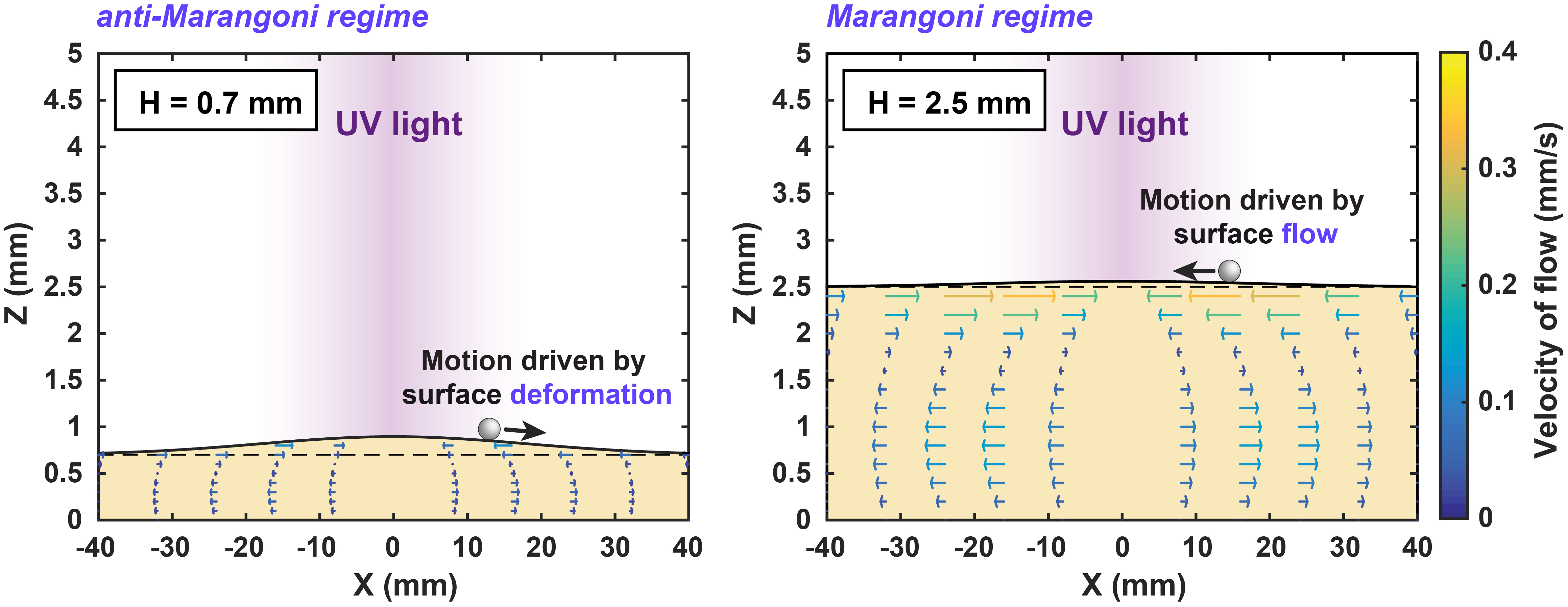Abstract:
Liquid marbles, liquid drops coated by a hydrophobic powder, have the remarkable property that they do not wet any solid nor liquid substrate, making their transport and manipulation both highly desirable (reduced contamination) and challenging (peculiar hydrodynamics). Here, we describe the optical transport of floating liquid marbles and emphasize a surprising motion behaviour. Water drops coated by hydrophobic nanoparticles are deposited on a water solution containing photosensitive surfactants. We show that irradiation of the solution generates photoreversible Marangoni flows that transport the liquid marbles toward UV light and away from blue light when the thickness of the liquid substrate is large enough (Marangoni regime). Strikingly, below a critical thickness, the liquid marbles move in the direction opposite to the surface flows at a speed increasing with a decrease in liquid thickness (anti-Marangoni regime). We experimentally and theoretically demonstrate that the anti-Marangoni motion is driven by the free surface deformation, which propels the non-wetting marble against the surface flow. We call this behaviour a “slide effect”. We show that the transition between the Marangoni and anti-Marangoni regimes occurs at a liquid thickness of the order of the capillary length of the system. This opens new horizons for contactless transport of capillary systems driven by surface flows and/or deformation.
Reference:
Liquid marbles, liquid drops coated by a hydrophobic powder, have the remarkable property that they do not wet any solid nor liquid substrate, making their transport and manipulation both highly desirable (reduced contamination) and challenging (peculiar hydrodynamics). Here, we describe the optical transport of floating liquid marbles and emphasize a surprising motion behaviour. Water drops coated by hydrophobic nanoparticles are deposited on a water solution containing photosensitive surfactants. We show that irradiation of the solution generates photoreversible Marangoni flows that transport the liquid marbles toward UV light and away from blue light when the thickness of the liquid substrate is large enough (Marangoni regime). Strikingly, below a critical thickness, the liquid marbles move in the direction opposite to the surface flows at a speed increasing with a decrease in liquid thickness (anti-Marangoni regime). We experimentally and theoretically demonstrate that the anti-Marangoni motion is driven by the free surface deformation, which propels the non-wetting marble against the surface flow. We call this behaviour a “slide effect”. We show that the transition between the Marangoni and anti-Marangoni regimes occurs at a liquid thickness of the order of the capillary length of the system. This opens new horizons for contactless transport of capillary systems driven by surface flows and/or deformation.
Reference:
Light-Driven Transport of a Liquid Marble with and against Surface Flows
N. Kavokine, M. Anyfantakis, M. Morel, S. Rudiuk, T. Bickel, D. Baigl*
Angew. Chem. Int. Ed. 2016, 2016, 55, 11183 –11187
![]() -doi : 10.1002/anie.201603639
-doi : 10.1002/anie.201603639
